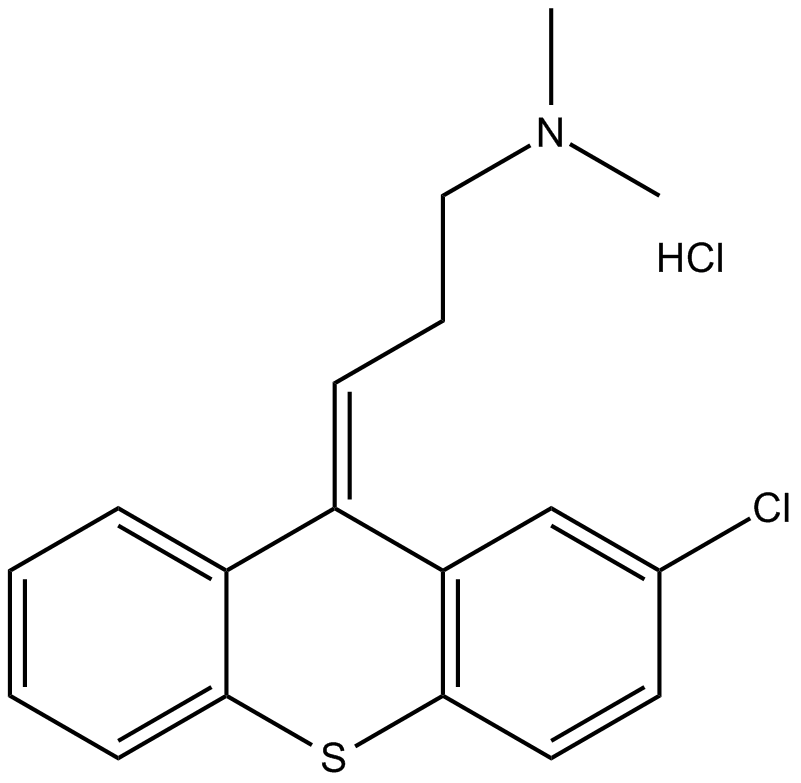Chlorprothixene (hydrochloride) (Synonyms: cis-Chlorprothixene,NSC 169899) |
| Catalog No.GC17656 |
dopamine D2 receptor antagonist and GABAA receptor inhibitor
Products are for research use only. Not for human use. We do not sell to patients.

Cas No.: 6469-93-8
Sample solution is provided at 25 µL, 10mM.
Chlorprothixene (hydrochloride) is an antagonist of dopamine receptor and histamine receptors [1]. Chlorprothixene is also an inhibitor of GABAA receptor [2]. All of these three receptors are implicated in many neurological processes, including motivation, pleasure, cognition, memory and learning.
In vitro: Chlorprothixene exihibited strong binding affinities to dopamine and histamine receptors, The Ki values of D1, D2, D3, D5 and H1 were 18nM, 2.96 nM, 4.56 nM, 9 nM and 3.75 nM, respectively. Chlorprothixene showed little affinity to H3 with the Ki value of >1000 nM[1]. In COS-7 cells transiently expressed rat 5-HT7 receptors and HEK-293 cells stably transfected with rat 5-HT6, the Ki values of chlorprothixene were 5.6 nM and 3 nM, respectively [3]. In Vero 76 cells, chlorprothixene treatment inhibited SARS-CoV replication, with IC50 of 16.7 μM for Urbani strain, 13.0 μM for Frankfurt-1, 18.5 μM for CHUK-W1 and 15.8 μM for Toronto-2 [4].
In vivo: In rat brain depressing the release of hypothalamic and hypophyseal hormones, chlorprothixene blocked postsynaptic mesolimbic dopaminergic D1 and D2 receptors [5]. Chlorprothixene treatment restored normal ceramide concentrations in murine bronchial epithelial cells, reduced inflammation in the lungs of mice with cystic fibrosis (CF) and prevented infection with Pseudomonas aeruginosa [6].
References:
[1] Von Coburg Y, Kottke T, Weizel L, et al. Potential utility of histamine H 3 receptor antagonist pharmacophore in antipsychotics[J]. Bioorganic & medicinal chemistry letters, 2009, 19(2): 538-542.
[2] Squires R F, Saederup E. Clozapine and several other antipsychotic/antidepressant drugs preferentially block the same ‘core’fraction of GABA A receptors[J]. Neurochemical research, 1998, 23(10): 1283-1290.
[3] Roth B L, Craigo S C, Choudhary M S, et al. Binding of typical and atypical antipsychotic agents to 5-hydroxytryptamine-6 and 5-hydroxytryptamine-7 receptors[J]. Journal of Pharmacology and Experimental Therapeutics, 1994, 268(3): 1403-1410.
[4] Barnard D L, Day C W, Bailey K, et al. Is the anti-psychotic, 10-(3-(dimethylamino) propyl) phenothiazine (promazine), a potential drug with which to treat SARS infections: Lack of efficacy of promazine on SARS-CoV replication in a mouse model[J]. Antiviral research, 2008, 79(2): 105-113.
[5] Gey K F, Pletscher A. Influence of chlorpromazine and chlorprothixene on the cerebral metabolism of 5-hydroxytryptamine, norepinephrine and dopamine[J]. Journal of Pharmacology and Experimental Therapeutics, 1961, 133(1): 18-24.
[6] Becker K A, Riethmuller J, Luth A, et al. Acid sphingomyelinase inhibitors normalize pulmonary ceramide and inflammation in cystic fibrosis[J]. American journal of respiratory cell and molecular biology, 2010, 42(6): 716-724.]
Average Rating: 5 (Based on Reviews and 13 reference(s) in Google Scholar.)
GLPBIO products are for RESEARCH USE ONLY. Please make sure your review or question is research based.
Required fields are marked with *




















